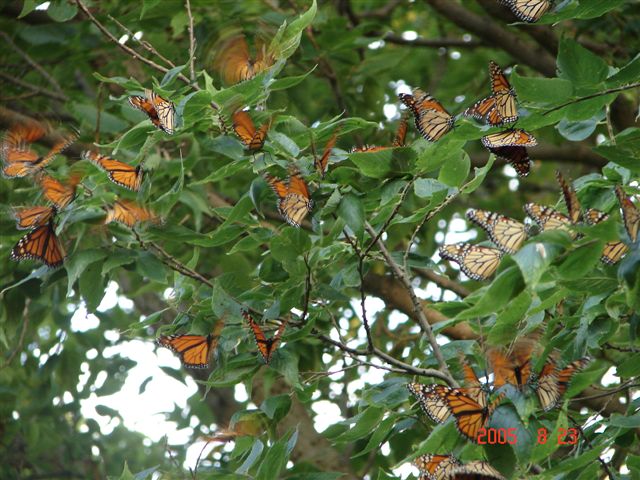Monarch Butterfly Migration Update: September 2, 2005
Today’s Update Includes
- Latest Migration Maps
- Highlights From the Migration Trail
- Why Do Monarchs Form Roosts? Clues from the Field
- Challenge Question #1
- Estimating the Number of Monarchs in a Roost: Let's Practice
- Why Do Nightly Counts Go Up and Down?
- Fly Like a Butterfly All the Way to Mexico
- Ultralight Plane Traveling with the Migration: Fly With Papalotzin!
- Habitat and Survival: What do Monarchs Need During Fall Migration?
- How to Report Your Observations
| Latest
Migration Maps Click for live maps--then read what each observer saw! |
||
 |
 |
 |
| ALL
Migration Sightings |
Sightings of Overnight Roosts | PEAK Migration Sightings |
Highlights
From the Migration Trail
A year ago at this time, most everyone was talking about how few monarch
butterflies there were. At best, only a handful of monarchs were being
seen at nectar sites or flying overhead, and not a single large roost
had been reported. What a welcome change this year! Already, southbound
butterflies have been seen at points across the map and people in the
north have found 27 large roosts. This year, everybody seems to be talking
about how many monarch butterflies there are. During the last week for
example:
- Thousands of monarchs in our fields today. Largest numbers at my location in many years!
- More monarchs in my yard tonight than I had for the whole season last year.
- We're seeing monarchs again after several years of no sightings.
Comments like these are signs that monarchs have rebounded during the summer breeding season. Yet how many monarchs there actually are, and what causes their numbers to rise and fall, are questions that baffle scientists.
Why
Do Monarchs Form Roosts? Clues from the Field
Migrating monarchs rest at overnight roosts at the end of the day. Imagine
finding a roost in your hometown, with hundreds or thousands of butterflies!
How might roosting help monarchs survive the migration? Read this week's
collection of observations and look for clues. Then answer Challenge Question
#1:
- Why
Do Monarchs Form Roosts? Clues from the Field
Challenge Question #1
To respond to this Challenge Question, please follow these instructions.
"Why do you think monarchs form roosts during migration? How might roosting help monarchs survive? (Give specific examples to support your answer.)"
Estimating the Number of Monarchs in a Roost: Let's Practice
People are dazzled by the beauty of fall "butterfly trees." It's rare to see more monarch butterflies than a person can count. Maybe this is why people always try to count them! If you were to discover a monarch roost, how would you count the butterflies? Scientists often use photographs to estimate numbers, whether they are counting whales or caribou, bats or butterflies. How many monarchs are in the roosts in these pictures?
 How
to Report Your Observations
How
to Report Your Observations
Put your monarch news on the map! Please send reports of monarchs feeding,
flying, and resting.
The Next Monarch Migration Update Will Be Posted on September 9, 2005.
Copyright
2005 Journey North. All Rights Reserved.
Please send all questions, comments, and suggestions to jn-help@learner.org
![]()
![]()
![]()
![]()
![]()
![]()













